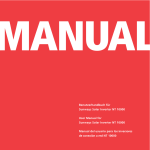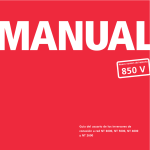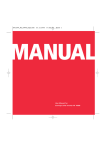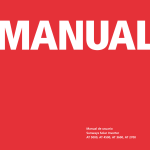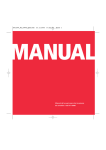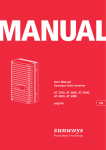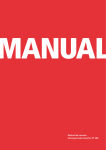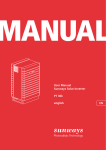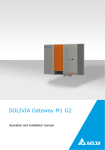Download User Manual for Sunways Solar Inverters NT 2600, NT 4000 and NT
Transcript
MANUAL User Manual for Sunways Solar Inverters NT 2600, NT 4000 and NT 6000 180 mm 300 mm 510 mm List of Contents 1.0 General information 1.1 Safety information 1.2 83 General safety information 84 Opening the unit Sunways Solar Inverters 85 Scope of supply, inspecting the delivery NT 2600, NT 4000 and NT 6000 86 Integration into the PV system Design of the PV generator 2.0 Information on installation 2.1 Safety information 87 Standard components of a PV system 88 Protection concept 90 Electrical safety Mechanical safety 2.2 79 Installation 91 Information on cleaning 93 Requirements on the place of installation 94 Electrical connection and cable entry 95 Grid connection 97 PV generator connection 98 Important Information 100 Communication connections 102 Connecting the sensors EN 2.3 Commissioning 3.0 Information on operation 3.1 Monitoring and diagnosis 3.2 Sunways NT Monitor software 104 Switching the solar inverter on and off 106 Configurations 108 Structure and menu levels for configuration 111 Display 112 Data memory 113 General information 114 Initialising the remote modem 115 Connection and circuitry options 120 Configuring the interface cables 122 Sunways NT Monitor data acquisition 123 Operation of Sunways NT Monitor 3.3 Fault indications 125 Screen displays 3.4 Fault diagnosis 127 Indications, causes and remedies 3.5 Warranty terms and conditions 130 Warranty period Terms and exclusion of liability for solar inverters 80 4.0 Appendix 4.1 Subject and abbreviation index 133 Designation and description 4.2 Function and information index 135 Functional principle and explanations 138 Block diagram 140 Technical data 144 TYCO SOLARLOK connectors 146 Conformity and safety declarations 150 General exclusion of liability, rights, registered trademarks 81 EN 1.0 General information 82 1.1 Safety information General safety information The User Manual contains safety hints. All safety hints contained in this section These are identified by a triangle with an and throughout the User Manual must exclamation mark. be complied with at all times to guarantee the user's safety. The described product ! must not be operated if any mechanical or electrical components are defective. Before commissioning the system, we strongly advise you to carefully read and heed the instructions! Non-compliance can have serious consequences, for example damage to the unit or other property or physical injuries with possible loss of life. The solar inverter must be installed by a trained, qualified electrician. The electrician must be approved by the competent electricity board (EB). The relevant tasks to be carried out are identified by an additional adjacent symbol in the respective chapter headings. 83 EN ! Opening the unit Before opening the cabinet, the unit must always be disconnected from the grid and from the PV generator. The unit continues to conduct a hazardous voltage internally and at the connection sockets for ca. five minutes after disconnecting from the PV generator. The energy storage capacitors are only fully discharged after this period. After disconnecting the unit from the grid and from the PV generator, you must wait at least five minutes before opening the unit. 84 1.2 Sunways Solar Inverters NT 2600, Inspecting the delivery NT 4000 and NT 6000 The condition of our products is checked Scope of supply prior to delivery. Although our products are carefully packed in recyclable packing, · Sunways Solar Inverter in the NT series transportation damages can still occur. · Installation frame These are generally the transport compa- · Manual, setup, warranty card, CD-Rom ny's responsibility. with software · 2 pairs of TYCO SOLARLOK connectors Please inspect the delivered solar inverter thoroughly! If you discover any damage to the packing or the solar inverter, please inform the transport company immediately. Your specialist dealer will be glad to assist you if required. Any damages must always be reported to the transport company in writing seven days after receipt of the goods at the latest. 85 EN Integration of the solar inverter into the PV system · Check your PV generator for soiling ca. every three years. This occurs particularly at the lower edge of the modules and Design of the PV generator forms a film, which even heavy rain cannot wash away. Decreases in yield can be The technical data of the selected PV prevented by cleaning with a wet cloth generator must be within the specifica- or a brush. tion of the solar inverter (see Technical Data). The Sunways NT Sundim design · Avoid shading of individual modules or program for the PV generator may be solar cells in your system. This can result helpful. Sunways NT Sundim is available in heavy losses in yield. on the enclosed CD or from our website, www.sunways.de. Please take account of the following points before planning your system: · Pay attention to the skyward alignment of the modules. You will obtain maximum yield in Central Europe with a module inclination of 30° to the horizontal and a direct southerly alignment of the generator field. · The output of the cells decreases as the module temperature increases. Install your PV generator with adequate rear ventilation. 86 Standard components of a PV system Depending on the recommendations of your electrician, your PV system will consist of the following components: Standard components of the PV system PV (1) (3) (2) PV generator switch: Designed as DC load break cut-out to cut off the PV generator from the solar inverter. Dimensioning: min. 800 V, ≥ 16 A Grid connection: 3-phase (Feed-in: 1-phase; grid monitoring: 3-phase) 87 (1) PV generator switch (2) Irradiation sensor with integrated temperature sensor (3) Mains fuse (4) Energy meter SUNWAYS NT PV (4) PC Grid EN Protection concept The following parameters are monitored continuously and in parallel by the microcontroller and displayed on the screen: · AFI error (ground fault) · Overheating of the cooling element · DC overvoltage · AC undervoltage/overvoltage In the event of a fault, the conversion is immediately blocked and the grid relay disconnected. In addition, the following protective devices are provided on both grid and PV generator side: · Grid-side varistors Protect the power semiconductors from high-energy, time-limited voltage spikes on the grid and provide for a reduction of energy in the throttle in the event of grid disconnection. · Generator-side varistors Thermally monitored varistors provide protection against atmospheric overvoltages (e.g. due to remote strikes during storms). 88 2.0 89 Information on installation 2.1 Safety information ! Electrical safety Before opening the cabinet, the solar inverter must be disconnected from the grid and from the PV generator. The solar inverter continues to conduct a hazardous voltage internally and at the connection sockets for the PV generator for ca. five minutes after disconnecting from the PV generator. The energy storage capacitors are only fully discharged after this period. After disconnecting the solar inverter from the grid and PV generator, you must wait at least five minutes before opening the solar inverter. Mechanical safety During installation, make sure that the cables or connection lines fitted to the solar inverter are securely laid and that suitable mechanical cable supports (cable ducts etc.) are used. 90 Information on cleaning ! Before cleaning, disconnect the system from the power grid by opening the grid breaker (main fuse) and open the DC switch on the PV generator, in order to exclude the danger of electric shocks. Use a soft, dry cloth to clean the system. Never use corrosive, solvent-containing or abrasive cleaners or polishes. 91 EN 2.2 Installation The solar inverter must be installed by a trained, qualified electrician. A special tool is ➟ 300 mm Warm Air ➟ necessary for installation. Please read this chapter very carefully. 150 mm ➟ 300 mm Cool Air ➟ 150 mm 92 Requirements on the place of installation If installing the solar inverter in a switch box, ensure adequate heat dissipation. · Mechanical bearing capacity During installation please bear in mind The ambient temperature must not fall that the solar inverter weighs 26 kg. The below or exceed –25°C or +40°C. installation base must be firm and capable of continuously bearing the weight. The solar inverter should not be exposed to direct solar irradiation, so as to protect it · Thermal interaction from unnecessary external heating. The installation base must consist of flame-retardant material (e.g. no wood or · Protection from damp and foreign bodies plastic in the base; concrete and brickwork The IP54 high protection class permits instal- are suitable), as the heat sink emits tempe- lation both inside and in roofed outdoor ratures up to max. 85°C. areas, but the solar inverter must not be exposed to direct rain. A minimum distance of 300 mm must be maintained above and below the cabinet, Make sure that the solar inverter cannot be and 150 mm on right and left from other exposed to foreign bodies (deposits of dust units, cabinets, ceilings, cable ducts etc.. and dirt). The solar inverter must be installed vertically, so as not to hinder adequate free convection. Several solar inverters must not be installed on top of each other, so as to prevent reciprocal heating. 93 EN Electrical connection and cable entry If the solar inverter is fixed to the installation frame, the electrical connection can be led through. The unit may only be ope- ! ned by a qualified electrician. The cabinet cover must first be released and removed. For installation, please observe the The following cable inlets are located on instructions in the "Setup" leaflet! the underside: RS 232, RS 485, Irradiation sensor with inte– DC – DC + DC Fig.: Inlets on the unit underside + DC grated temperature sensor AC wiring loom cable L1, L2, L3, N, PE 94 Grid connection As line safety element in the grid feed-in direction, we recommend a 3 x 25 A automatic cut-out. No consumption units must ! be connected to the feed line from the solar inverter to the automatic cut-out. The solar inverter only feeds in via termi- The grid connection of the solar inverter nal L1. must have 5 wires (L1, L2, L3, PE, N). Cable cross-sections of 5 x 4 mm2 are recommen- If several solar inverters are operated in ded. parallel, the feed-in phase L1 of the unit must be evenly distributed over grid phases L1, L2 and L3 (see figure below). The solar inverter is connected to the supply grid via the circuit board terminals inside the unit. Three-phase grid connection distributed over three units L1 N L2 L3 PE L1 L2 L3 N PE 95 L1 N L2 L3 PE L1 N L2 L3 PE EN You must use adequately dimensioned · Connect cables L1, L2, L3, PE and N to cable cross-sections in order to avoid a the relevant circuit board terminal with considerable increase in the grid impedan- the help of a slot-head screwdriver (see ce between the domestic distribution and figure below). the solar inverter. The terminal range of the AC terminals is 0.5 to 6 mm2 for rigid cables and 0.5 to 10 mm2 for flexible cables. With a high grid impedance, i.e. with a long line or too small a crosssection, the voltage increases at the grid terminal during feed-in. If the terminal voltage exceeds the permissible value, the solar inverter is disconnected from the grid. · Tighten the M25 screw connection, so Carefully perform the following steps: that the cable cannot exert any mechanical force on the circuit board terminal. · Check that there is no voltage before introducing the supply main into the unit. · Lead the 5-core AC cable (outer diameter 9 – 17 mm) through the M25 threaded cable gland. 96 PV generator connection · Connection The PV generator is connected via the ! externally accessible, shock-proof TYCO SOLARLOK connectors, which are enclosed with the delivery. The TYCO SOLARLOK connectors are designed for a cable cross- · Preparation section of 4 mm2 and must be crimped Execute the DC cabling according to your (see data sheet and connector assembly electrician's system dimensioning. Check with TYCO crimping tool on page 144). each PV string for correct functioning by performing a no-load voltage current Connect the two right DC female connectors and short-circuit current measurement. with «+», the two left DC female connectors with «-» of the PV generator (see figure To achieve the necessary protection against hazardous contact voltage during the installation of PV systems, the positive and negative conductors must be kept separate from the ground potential (PE). Contactable, conductive parts of the PV generator (e.g. metal frame, supporting structure etc.) must be earthed (connected to PE). Check that the generator is free from ground faults. Make the electrical connection to the 97 solar inverter. below). EN Important information ! · The direct PV generator voltage is available internally after connecting the PV generator to the solar inverter via the DC connectors and switching on the PV generator switch! · Please note that the input capacitors are still charged even after switching off the PV generator switch or removing the PV generator plug connection! · After disconnecting the AC and DC side, the solar inverter still conducts voltage for up to ca. five minutes! · Therefore, wait for at least five minutes until the internal voltage has dissipated. Then you can work on the terminals! Please note the general safety information on pages 83 and 84! 98 · The DC voltage can be up to 750 V. The unit may only be opened by a qualified electrician! · Always disconnect the PV generator side first by opening the PV generator switch, and then the grid connection by isolating the relevant mains fuse! · If you do not have a PV generator switch in your PV system, you must disconnect the grid connection first of all by isolating the relevant mains fuse. However, a «grid error» will be entered in the error memory of the solar inverter! · Disconnection of the PV generator by removing the TYCO SOLARLOK DC connectors must never be performed under load. In the event of non-compliance, the connectors could be damaged by a strong electric arc. In this case, the relevant connectors must be replaced! 99 EN Communication connections A 3-core cable is used for signal transmission via the RS 232, and a 2-core cable for ! the RS 485 interface Via the communication connections (interfaces), operating data can be retrieved from the data memory with an external computer and specific operating settings made. Two interfaces are available: RS 232 and RS 485. The standard communication interface is (Top figure) RS 232 and RS 485 interfaces the RS 232 interface, which is installed in with the signals (from left to right): all current PCs and notebooks. This inter- RS 485+, RS 485+, RS 485-, RS 485-, GND_G, face allows you to establish contact with TX, RX, GND_G, TX 2, RX 2. your PC immediately, using a connecting cable. The use of more than one solar Attention: RS 485+ and RS 485- are dupli- inverter or cable lengths of more than cated. This means that the cable entry and 50 m requires the use of the RS 485 exit are additionally clamped. interface. The connections for the RS 232 or RS 485 interface supply cable are also made via circuit board terminals and via the M12 screwed cable glands in the cabinet. 100 · Connection Seal the unrequired cable glands by Remove the cover of the solar inverter placing a spare piece of cable in the gland before connecting an interface cable. Pay hole and tightening with the screw clamp. heed to all safety hints (Pages 90 and 91). Please heed the description on the You will find the necessary cable terminal Sunways NT Monitor software in block with the RS 485+, RS 485-, GND_G, Chapter 3.2. TX, RX, GND_G, TX 2, RX 2 connections on the board in the centre, bottom left (see figure on the left). Note the following terminal configuration: RS 232: GND, RX, TX RS 485: RS 485+, RS 485(The remaining signals, TX2 and RX2, are only for service purposes.) Use a small screwdriver. Press the orange terminal. The terminal will open. Insert the cable stripped to a minimum of 11 mm into the respective terminal hole. Release the screwdriver. The cable is fixed in the connection. Once again, check that the cable connec101 tion is firmly located. EN Connecting the sensors Before you connect an irradiation sensor, you must remove the cover of the solar ! inverter. Pay heed to all safety hints on pages 90 and 91. Please note that the inputs and outputs are not short-circuit resistant. · Optional irradiation sensor The optional addition of an irradiation The optional irradiation sensor with sensor (type Si-01TC-T from Ing.-Büro temperature sensor is connected to the Mencke & Tegtmeyer ) with integrated corresponding terminals at the bottom PT-100 temperature sensor for tempera- right of the middle board. ture measurement enables recording of the irradiation data and the corresponding module temperature in the cycle of the internal data memory. This additional measuring unit helps with analysis of the system. On the basis of the values, possible errors in the PV generator, such as e.g. shading or failure of solar cells, can be detected. (Top figure) Connection block for For demonstration purposes, the irradia- temperature sensor cables with the signals: tion sensor and the corresponding data Temp, Solar, V+ and V-. can be used to show how a PV system functions. In conjunction with the Sunways NT Monitor visualisation software, the stored data can be displayed. 102 Configuration of the cable terminal block: Temperature sensor measuring signal: Temp Solar radiation measuring signal: Solar Positive supply, 5V: V+ Supply, GND: V- Using a small screwdriver, press the orange terminal. The terminal will open. Insert the cable stripped to a minimum of 11 mm into the respective terminal hole. Loosen the screwdriver. The cable is fixed in the connection. Once again, check that the cable connection is firmly located. Seal the unrequired cable glands by placing a spare piece of cable in the gland hole and tightening the screw clamp. 103 EN 2.3 Commissioning Switching the solar inverter on and off Connect the solar inverter internally via · Switching on the ground cable (yellow-green) to the When the solar inverter is mechanically cabinet cover. (See also Setup, step 7) installed and connected to the electrical cables, the unit can be commissioned as Put the cabinet cover on. follows: Screw it down tightly with the four Switch the grid connection on through screws on the front. the external safety cutouts. Do not place any objects (e.g. this manu- Switch the PV generator voltage on by al) on the cabinet of the solarinverter. closing the PV generator switch. The solar Free ventilation behind the solar inverter inverter will start up with adequate must be able to take place unimpeded. PV power. If the PV input voltage is high enough, the solar inverter will begin ope- If the unit is installed in the open air, ration and feed the solar energy into the please take special care to ensure that the electrical grid. You can see the operation screwed cable glands are properly sealed on the display. The current feed-in power and that the cabinet cover is precisely is shown here. located. The solar inverter is supplied by the PV generator. The solar inverter switches on in the morning and off again in the evening. The relevant switching on and switching off thresholds are defined for the PV generator. If the solar energy is not sufficient to supply the electronics, several switch-on attempts may have to be made 104 in cloudy weather. This is normal, and does not affect either the yield or the mode of functioning of the solar inverter. ! · Switching off Open the main switch for the PV DC Disconnect the PV generator side first by voltage and the mains fuse as described opening the PV generator switch, and above. After a waiting period of at least then the grid connection by isolating the five minutes, the solar inverter will be relevant mains fuse. voltage-free. If your PV system does not have a PV Disconnection of the PV generator by generator switch, you must disconnect removing the TYCO SOLARLOK connectors the grid connection first of all by isolating must never be performed under load. In the relevant mains fuse. When you do the event of non-compliance, the connec- this, a "grid error" will be entered in the tors could be damaged by a strong electric error memory of the solar inverter. arc. In this case, the relevant connectors must be replaced! If the solar inverter is to be completely disconnected (e.g. removal) from the PV Remove the cabinet cover. system, reconfigured or extended, the 105 cabinet cover must be removed. Pay heed Check that the grid connection terminals to all safety hints (Pages 90 and 91). are voltage-free. EN Configurations However, language setting, LCD contrast and total energy offset (only to be used The solar inverter is basically configured in the event of replacement) must be with the Sunways NT Monitor program, configured directly on the unit. If you wish using a laptop or PC (see enclosed CD). to configure the solar inverter without an external laptop or PC, or to change the In this regard please read the chapter language setting, please follow the «System Monitoring and Diagnosis» and instructions below: «Sunways NT Monitor». ! Disconnect the solar inverter by isolating the mains fuse from the grid. The direct configuration of the solar inverter occurs with PV operating voltage present! Please note that the unit is under DC voltage for configurations via the keys. Danger to life! Please observe all essential regulations for «Working under voltage»! 106 This is the only exception for which work · Address of the solar inverter: address may be performed on the open unit under «1» is stored in the memory at the voltage! factory. In the case of several solar inverters, consecutive numbering must be set. Remove the cabinet cover to carry out the For three solar inverters e.g. the addres- configuration. ses «1», «2» and «3». · Date The following settings can be performed · Time using the illustrated keys: · Language (German or English) EN PLUS 107 MINUS ESC/CUR UP/DWN Fig.: The setting keys are located beneath the display. RST Use insulating material to press the keys resets the data recording program to its (e.g. a plastic rod). Avoid direct contact original status. This does not affect the with the printed circuit board, so that the operation of the solar inverter. electronics cannot be damaged by electrostatic charging. The reset key (RST) only Starting from the current display on the Structure and menu levels for configuration PERFORMANCE AND OPERATING DATA ESC CUR UP/ DWN ▲ START SOLAR INVERTER ADDRESS UP/ DWN + ADDRESS 1 ... 99 DATE +/– UP/ DWN UP/ DWN UP/ DWN + – DAY TIME +/– UP/ DWN + – + MONTH YEAR + – ESC CUR ESC CUR + HOURS UP/ DWN – ESC CUR ESC CUR ESC CUR +/– – MINUTES – ESC CUR + SECONDS – ESC CUR SAVE 108 screen, you can reach the next menu level with the UP/DOWN key. The illustrated structure facilitates settings on the menu levels. Then save your settings by pressing the ESC/CUR key. LANGUAGE +/– UP/ DWN UP/ DWN + ENG./GER. LCD CONTRAST – UP/ DWN + CONTRAST – +/– SOFTWARE VERSION TOTAL POWER OFFSET +/– UP/ DWN + k Wh ESC CUR INCREMENT (100 OR 1) 109 UP/ DWN UP/ DWN – 3.0 Information on operation 110 3.1 Monitoring and diagnosis Display The dot matrix LCD display is integrated into the cabinet of the solar inverter so that it is easily visible. The display consists of 16 characters and 2 lines. The top line 1 shows the current feed-in power of the solar inverter. The bottom line 2 outputs EN operating data. The data can be displayed in the German or English language. Line 1 Current fed-in power Power kW Line 2 AC voltage U-AC V DC voltage U-DC V Daily yield in Wh W_TAG Wh Total yield in kWh W_GES kWh Irradiation in W/m2 (*) SOLAR Wm2 PV generator temperature in °C (*) TEMP-PAN Time (* if the optional irradiation sensor with integrated temperature sensor is connected.) 111 C Data memory · Storage of accumulated daily work in Wh and of 40 daily values in the recircu- Your solar inverter is equipped with an internal data memory as standard. This data memory provides you with a detailed lating storage and successive overwriting of values · Storage of accumulated monthly work in view of the mode of functioning and the kWh and of 13 monthly values in the relevant values of your solar power supply recirculating storage, then overwriting at all times. You can access these data of values with the help of the NT Monitor software · Storage of faults with max. ten values, described below. The following measured then successive overwriting of values values can be determined: Please note that all displayed performance · DC voltage data are displayed with a nominal measu- · AC voltage and AC current (power calcu- ring accuracy of maximum 5 %. The energy lation) · Irradiation and module temperature counter of your EVU should be used as absolute reference for the fed-in energy. (if a sensor is connected) · Time and date The following values can be accumulated, stored and successively overwritten: · 15 minute values for AC current, DC and AC voltages, irradiation and temperature · 120 times storage of 15-minute average values in the recirculating storage; storage depth: three days on average, then overwriting of values 112 3.2 Sunways NT Monitor software be transferred via a modem. We recommend using two external analogue General information modems made by ACER. If other modems are used, the functional reliability cannot The Sunways NT Monitor visualisation soft- always be guaranteed. ware was developed for PV system monitoring and configuration of the solar inverter The modem (remote modem) installed using PC. It is contained on the enclosed CD in the solar inverter must be initialised and can also be downloaded free of charge prior to installation with the help of the on the Internet from www.sunways.de. Sunways NT Monitor software. Note the System prerequisites are: "Help" function in the program in this regard. · Intel Pentium from 100 MHz or higher · Microsoft Windows 95/98/2000/NT The second modem (local modem) is · At least 6 MB free hard disk storage space connected to the RS 232 interface of your · At least 16 MB main memory PC. This modem must not be initialised. · VGA monitor with at least 800 x 600 (120 dpi) resolution Different interface cables are required, depending on the type of connection. All measured values can be transferred These are included in the accessories. to a PC and visualised with the Sunways NT Monitor software. Online, fault, minute, Up to 99 solar inverters can be monitored daily and monthly values are available. and read out by means of a connection via the RS 485 interface. For connecting to your PC, Sunways solar 113 inverters in the NT series are equipped with If the data are read out via the RS 485 the RS 232 and RS 485 interfaces as stan- interface and converted to RS 232 with dard. In the case of larger distances bet- an interface converter, we recommend ween PV system and PC, the data can also the converter type «I-7520 Converter» EN from ICP-Deutschland, (available from your specialist dealer), which will guarantee · Attention! Do not initialise the local modem! reliable data transfer. · The remote modem is now initialised The addresses of the solar inverter must so that it automatically accepts a connec- be input in the solar inverter using the tion after two rings and connects at Sunways NT Monitor software or input 9600 Baud. directly with the keys illustrated on page 107. Initialising the remote modem If a remote modem is installed in the solar inverter, it must be initialised using a PC and the Sunways NT Monitor software. · Connect the powered remote modem to the PC via the COM port. Use the interface cable provided with the modem for this purpose. Start the Sunways NT Monitor and set «Acer Modem» under the «Settings/Remote Modem» menu. · Click «Perform initialisation» and wait until the scroll bar has come to an end. The modem can now be switched off and connected to the solar inverter via the RS 232 interface. 114 Connection and circuitry options INVERTER (1) Individual PV system with maximum distance of 50 m between solar inverter and PC PV RS 232 PC Yellow Green Brown Connection to PC via RS 232 A single solar inverter can be directly connected to a PC via the RS 232 interface RS 485+ RS 485+ RS 485– RS 485– GND_G TX RX GND_G TX 2 RX 2 Stripped length: 11 mm Jumper JP400: open (1) This connection can be used to read out an individual solar inverter if the distance from the PC used does not exceed 50 m. To do this, cable type A is stripped to 11 mm and connected to the solar inverter. 115 INVERTER (1) (2) Individual PV system with modem for remote inquiry PV RS 232 MODEM MODEM RS 232 PC Green Yellow Brown Connection to modem via RS 232 When connecting an individual solar inverter, the remote modem is connected directly to the RS 232 signal. RS 485+ RS 485+ RS 485– RS 485– GND_G TX RX GND_G TX 2 RX 2 Stripped length: 11 mm Jumper JP400: open (see page 121) (2) To install the remote inquiry of an individual solar inverter, the RS 232 signal can be routed directly from the solar inverter to the remote modem. Cable type B is used for this purpose. For the RS 232 connection between solar inverter and modem, a cable length of 50 m should not be exceeded. 116 PV INVERTER (1) PV INVERTER (2 to 99) (3) PV system for 2 to 99 solar inverters with interface converter (I C) RS 485 IC RS 232 PC RS 485+ RS 485+ RS 485– RS 485– GND_G TX RX GND_G TX 2 RX 2 RS 485+ RS 485+ RS 485– RS 485– Connection to PC via RS 485 / RS 232 117 In order to connect several solar inverters to a PC, the RS 485 signal is looped through from inverter to inverter, until it is led into the interface converter. From here, the RS 232 signal is conducted to the PC. Jumper JP400 is connected to the solar inverter that is furthest away from the interface converter. It must be open for all other solar inverters. Stripped length: 11 mm Jumper JP400: see above (3) Up to 99 solar inverters can be con- the interface converter and the furthest nected together and read out using this solar inverter. The individual solar inverters connection. In this case, there is a maxi- are connected together via the RS 485 mum cable length of 500 m between interface. The signal is looped through all units. Two The interface converter generates an «RS 485+» terminals and two «RS 485-» RS 232 signal. It is connected to the PC with terminals are located on each terminal the standard modem cable type D. Jumper block. This means that the signal can be led JP400 must be closed at the solar inverter into the solar inverter at one terminal and that is furthest away from the interface out of the solar inverter at the other termi- converter. For all other solar inverters it nal. The RS 485 signal is led out of the last must be open. An address must be alloca- solar inverter in the series into the interface ted, to enable identification of the indivi- converter using the following configuration: dual solar inverters. This is described in «RS 485+» to «DATA+» and «RS 485-» to Chapter 2.3 Commissioning, under «DATA-». «Configuration». (4) PV system for 2 to 99 solar inverters with interface converter (IC) and modem for PV INVERTER (1) PV INVERTER (2 to 99) remote inquiry RS 485 IC RS 232 MODEM MODEM RS 232 PC 118 RS 485+ RS 485+ RS 485– RS 485– GND_G TX RX GND_G TX 2 RX 2 RS 485+ RS 485+ RS 485– RS 485– Connection to modem via RS 485 / RS 232 (4) If several solar inverters are to be connected to the remote inquiry, then the individual inverters are connected together by means of the RS 485 signal, as when reading out several units locally. This signal is converted by the interface converter into the RS 232 signal, from where it is led to the modem using cable type C. Jumper JP400 must be closed at the solar inverter that is furthest away from the interface converter. For all other solar inverters it must be open. An address must be allocated, to enable identification of the individual solar inverters. This is described in Chapter 2.3 Commissioning, under 119 «Configuration». In order to connect several solar inverters to the remote monitoring, the interface converter is connected directly to a modem via RS 232. Jumper JP400 is connected to the solar inverter that is furthest away from the interface converter. It must be open for all other solar inverters. Stripped length: 11 mm Jumper JP400: see above Configuring the interface cables Cable type A Female connector to PC, 9-pole 6 7 8 9 1 2 3 4 5 6 7 8 9 1 2 3 4 5 TX RX Signal cables to the solar inverter on X400 GND Cable type B Connector to modem, 9-pole RX TX Signal cables to solar inverter on X400 GND 120 Cable type C Connector to modem, 9-pole 6 7 8 9 1 2 3 4 5 Locating jumper JP400 in the Sunways Solar Inverter Please check the correct position of jumper JP400, depending on your selected communication circuit. You will find this jumper above the communication connections (see figure opposite). 121 5 4 3 2 1 9 8 7 6 Connector to interface converter Sunways NT Monitor data acquisition · Monthly values Date in the solar inverter, fed-in since · Online values commissioning and monthly energy. DC voltage (U_DC), AC voltage (U_AC), AC current (I_AC), date, time, AC power, Representation as graphic or print; Option module temperature, module irradiation, of saving as bitmap; Zoom-in of graphics «fed-in today», «fed-in since commissio- possible. Individual solar inverters can be ning», error. called up with the scroll menu. · 15 minute values · Fault data DC voltage (U_DC), AC voltage (U_AC), Date, time and type of fault (for the AC current (I_AC), date, time, temperature, last ten faults) irradiation, «fed-in in 15 minutes», accumulated daily total of all 15 minute average · Calendar values. Date and time in the solar inverter Representation as graphic or print; Option · Modem of saving as bitmap; Fade-in of graphics Selection of the modem type and input possible. Individual solar inverters can be of the address signal called up with the scroll menu. If required, detailed information on · Daily values Sunways NT Monitor can be found under Date and daily energy in the solar inverter. the «Help» menu item in the program software. Representation as graphic or print; Option of saving as bitmap; Zoom-in of graphics possible. Individual solar inverters can be called up with the scroll menu. 122 Operation of Sunways NT Monitor solar inverter in the top section of the right window half and the new number After installing the Sunways NT Monitor beneath it. The numbering is changed software on your PC, you can start the by clicking on the «Make change» key. program. The word «Sunways» will now appear on your screen. Exit the window with the «Close» key. You will go back to the «Setting» menu. On the menu bar at the top, you will see the four menu areas «Program», «Data», You can set the interface configuration «Settings» and «Help». with your PC by clicking on the «Connection» key. · Setting menu By clicking on the «Remote modem» To configure your solar inverter, open the key, you can configure an optional modem «Settings» menu by clicking on it with (e. g. if you wish to retrieve data by the mouse, and click on the «Inverter» key. remote inquiry). Enter the address number that you have defined for your solar inverter next to «Inverter». For example, the number «1» · Data menu for one solar inverter. In the case of In the «Data» menu, you can call up several units, select «all». the current accumulated performance and energy of the solar inverter by clicking Then enter the desired date and time. The on the «Online» key. settings are transferred to the solar inverter by clicking on the «Make change» key. You can display the data measured at 15 minute intervals by clicking on the 123 If you are using several solar inverters and «Minute values» key. The data and values wish to make a change to the numbering, are graphically visualised by clicking on you can enter the old number of the the «Graphic representation» key. EN You can call up «Daily values» and «Monthly values» in the same way, by clicking on the respective keys. Exit the window with the «Close» key. You will return to the «Settings» menu. · Help menu You will find further helpful information on operating the Sunways NT Monitor software in the «Help» menu. 124 3.3 Fault indications Your solar inverter operates fully automati- Display for AC undervoltage: Line 1 Error: UAC_3 Line 2 Undervoltage cally and maintenance-free. However, if operational faults occur due to external or internal causes, these will be displayed on the screen. · AC over/undervoltage (1-phase) · AC over/undervoltage (3-phase) Your solar inverter monitors the limits of Your solar inverter monitors the limits of minimum and maximum permissible grid minimum and maximum permissible voltage in the feed-in phase. If these limits 3-phase grid voltage. If these limits are are exceeded, the solar inverter will switch exceeded (Umin = 184 V, UN = 230 V, off and will only start up again when the Umax = 264 V), the solar inverter will switch voltage value is within the limits. off and will only start up again when the voltage value is within the limits. The Display for AC overvoltage: fault cut-out can be triggered even by very 125 brief overvoltages and undervoltages. Line 1 Error: UAC_1 Display for AC overvoltage: Line 2 Overvoltage Line 1 Error: UAC_3 Line 2 Overvoltage Display for AC undervoltage: Line 1 Error: UAC_1 Line 2 Undervoltage EN · DC overvoltage Display for AFI error protection: A maximum no-load voltage of 750 V is permitted for the PV generator. Line 1 Error: AFI Line 2 Residual current All components of the DC input are adequately dimensioned with a safety factor. If the threshold is exceeded, the solar inverter stops the feed-in and a «DC overvoltage error» is displayed. · Overheating fault Your solar inverter is designed for an Display for DC overvoltage: ambient temperature of up to +40°C. When the maximum upper temperature Line 1 Error: UDC Line 2 Overvoltage threshold is reached, the feed-in is stopped. When the heat sink temperature has decreased, the solar inverter starts up again automatically. · AFI residual current Line 1 Error: TEMP Line 2 Overtemperature The AFI residual current (insulation error, ground fault) is displayed if a residual current has occurred in the PV system and the solar inverter has subsequently disconnected from the grid. Ground faults are monitored on both the AC and DC side (universal current-sensitive FI). If this error message is displayed, the entire PV system must be checked for insulation errors. The AFI residual current operated device only monitors the phase into which feed-in occurs. 126 3.4 Fault diagnosis Fault display Causes Remedies Overtemperature The maximum permissible The installation location is not suitable. ambient temperature of Please find another installation location. 40°C has been exceeded. The necessary air circulation Clean the solar inverter if dirt is was not taken into account impeding the cooling unit. during installation. Objects have been stored on Remove the objects. the heat sink, impeding free convection. 127 UDC The maximum DC voltage Check the dimensioning of your Overvoltage has been exceeded. PV generator. Too many modules are con- Reduce the number of modules and nected in series. re-commission the system. Fault display Causes Remedies UAC_1 The grid voltage is too low The solar inverter monitors the limits of UAC_3 or too high. the minimum and maximum permissible AC under/over- 3-phase grid voltage. If the values exceed voltage or fall below these limits (Umin = 184 V, Umax = 264 V), the solar inverter switches off and only restarts automatically when the voltage value has returned within the limits. The fault cut-out can be triggered even if the values only exceed or fall below the limits very briefly (up to ca. 1 ms). Ask your electricity board about grid stability and design. The cable cross-section in Check the format of your grid connection the AC feed line to the solar (energy counter) and the grid feed-in inverter is too small. point to your electricity board. Your solar system feeds into a spur line, which is inadequately dimensioned. 128 Fault display Causes Remedies AFI The AFI error is displayed if The entire PV system must be checked Residual current a residual current has occur- for insulation errors. red in the PV system and the solar inverter has subsequently disconnected from the grid. Incorrect time, Have the battery (button cell) replaced by an expert. in Sunways NT The battery is located on the LCD display Monitor with board. incorrect time data. 129 The battery is empty. date are stored 3.5 Warranty terms and conditions Sunways AG must be allowed the necessary time to eliminate the defect. Sunways AG will endeavour to eliminate the defect · Warranty period within 14 days of receipt of the unit. If this The warranty period is five years from is not possible, the customer will be infor- purchase of the solar inverter by the end med of the reason and the time when the user. Please complete the enclosed war- defect will be eliminated will be specified. ranty card and return it to Sunways AG. Please keep the original invoice with the Please preserve the original packing, date of purchase in a safe place. This will even after expiry of the warranty period. be required as proof, in addition to the Carriers may only accept solar inverters in warranty card, in the event of a claim. transport-safe original packing. Therefore, please inform us before collection if you · Conditions have lost the original packing. We will During the warranty period, the solar gladly provide you with new packing for inverter will be repaired free of labour a charge. and material costs in Constance. Installation costs are borne by the customer, unless agreed otherwise. The completed warranty card must be sent to Sunways AG, Constance within seven days of purchase. Please notify us of any warranty claims by telephone (technical hotline: +49 7531 99677577), stating your name, address, telephone and serial number, and your email address if applicable. 130 · Exclusion of liability Warranty claims and liability are excluded for direct or indirect damages due to: · Interventions, modifications or attempted repairs · Inadequate ventilation · Force majeure (e.g. lightning strike, water damage, vandalism, fire, overvoltage, thunderstorms etc.) · Inappropriate transport · Non-observance of pertinent regulations or incorrect installation or commissioning · Leakage of overvoltages from the varistors on the DC side on the PV generator More extensive or other claims for direct or indirect damages, particularly claims for damages, including those arising from positive contract violation, are excluded, unless legally prescribed. 131 EN 4.0 Appendix 132 4.1 Subject and abbreviation index Designation Description AC Alternating Current: grid current AFI, RCD Operator protection in the event of residual currents AFI: Universal Sensitive Residual Current RCD: Residual Current Device EN DC Direct Current PV generator side of the solar inverter EMV Electromagnetic Compatibility EB Electricity Board INDC Current used to operate the solar inverter IP Identification of class of protection against external environ-mental influences (penetration of water and mechanical foreign bodies) 133 kW Kilowatt LCD Liquid Crystal Display MPP Maximum Power Point Designation Description Grid impedance AC resistance of grid, impedance PNDC PNAC DC and AC rated power: Power which the inverters can permanently consume (DC) or emit (AC). PT Temperature sensor PV Photovoltaic PV generator switch DC load break switch to cut off the PV generator from the solar inverter UNDC Voltage: specifies the normal operating voltage at which the solar inverter is operated 134 4.2 Function and information index · DC and AC filters The DC and AC filters are specially designed Functional principle and explanations EMC filters, which are integrated as direct components on the board. They guarantee The electrical energy of the PV generator compliance with the EMC limit values on is buffered by a capacitive storage, from the AC side and on the PV generator side. where it is fed into the public grid via a High-frequency emissions are avoided by solar inverter synchronised with the grid, the filters on the PV generator side. with an ideal phase angle of [cos phi = 1]. · Differential measurement A sinusoidal current with a very low harmo- The generator current and the voltage are nic distortion is injected into the public recorded via a current transformer and a grid by the current injection inductor. This differential measurement. The values are improves the grid quality. important input values for the regulation and setting of the correct working point. Thanks to the HERIC® technology (patent applied for) in the self-commutated · Solar inverter with HERIC® technology Sunways Solar Inverter, the hysteresis losses The heart of the solar inverter with the in the current injection inductors that power semiconductors serves for conver- occur in conventional solar inverters and sion of the current from direct into the switching losses in the semiconductors alternating current. Peak efficiencies are are considerably reduced. Consequently, achieved, thanks to the HERIC® techno- Sunways Solar Inverters achieve a peak logy. The switching frequency (PWM) is efficiency during conversion. The concept 16 kHz. of the Sunways Solar Inverter is completed by a rapid MPP control, which maintains the MPP point with a very high adaptation efficiency. 135 EN · Grid protection · Sensor interface The grid protection is a powerful relay An irradiation sensor with integrated which ensures reliable grid disconnection temperature sensor can be optionally con- in the case of error and for night switch- nected to the relevant interface. This off. This relay fulfils the requirement for allows first time users to quickly grasp the trouble-free grid disconnection. mode of functioning of their PV system, and facilitates monitoring of the PV · Microcontroller system for professionals. As well as system management, the efficient microcontroller undertakes · AFI universal sensitive residual current additional tasks, such as saving data device and communication. The universal (DC and AC) sensitive residual current device (AFI) monitors the solar · LCD display system for residual currents. To do this, Important information for the operator it disconnects the solar inverter from the about the system operation and status is grid by means of a relay as soon as a resi- displayed on an LCD display of 2 x 16 dual current occurs on the PV generator characters. side or on the AC side in the solar inverter. After cutoff by the relay and as soon as · RS 485 and RS 232 interfaces the residual current has stopped, the AFI The two RS 485 and RS 232 interfaces automatically attempts to reconnect the installed as standard serve for communi- solar inverter to the grid. The AFI of the cation with the solar inverter and the PV Sunways solar inverter complies with system. The system can be visualised via standard DIN V VDE V 0126-1-1. the Sunways NT Monitor software. In addition, the AFI of Solar Inverters NT 2600, NT 4000 and NT 6000 has an absolutely time-independent effective value 136 cutoff threshold, which is dependent on the performance class. The NT 2600 model is switched off at an absolute residual current of 130 mA, the NT 4000 model at an absolute residual current of 200 mA and the NT 6000 model at an absolute residual current of 300 mA. The AFI triggers within < 0.2 seconds. · MPP control The solar inverter has a rapid MPP control, which maintains the MPP point with a very high adaptation efficiency. If surplus power is provided by the PV generator, the solar inverter limits this by shifting the working point of the characteristic curve of the PV generator, so as not to exceed the maximum permissible AC feed-in power in accordance with VDEW. 137 EN Block diagram = PV-GENERATOR DC-FILTER HERIC® CAPACITIVE STORAGE ≈ TEMP CONTROLLER IDC UDC DIFFERER. MEASUREMENT RADIATION AND TEMPERATURE CONTROL DATAPRO DATA RT IRRADIATION SENSOR AND TEMPERATURE SENSOR (OPT.) RS 232 RS 485 MICROCONTROLLER 138 CURRENT IMPRESSION INDUCTOR AFI AC FILTER GRID PROTECTION RESIDUAL CURRENT AFI AND CESSING IAC UAC DIFFERER. MEASUREMENT LCD-DISPLAY (2 LINES) 139 KEYBOARD GRID L 1, L 2, L E N, P E Technical data Model Solar Inverter NT 2600 Recommended PV generator power 1500 bis 2750 W DC Rated input power Stand-by consumption Night-time consumption AC energy generated from Nominal voltage UMPP voltage range Open-circuit voltage Switch-on voltage Switch-off voltage Maximum current Nominal current Number of inputs Maximum efficiency European efficiency (weighted) HERIC® topology AC Rated continuous output power Pn Maximum power Pp Nominal frequency Grid voltage Grid voltage tolerance range Nominal current Max. current Distortion factor at Pn Reactive power factor (cos phi) Output current 2300 W 9W < 0.005 W 15 W 400 V 350 ≤ UMPP ≤ 650 V 750 V 410 V 340 V 7A 5.75 A 2 (with adapter: 4) 97 per cent 96.5 per cent yes 2200 W 2200 W 50 Hz +/- 0.2 230 V - 20 to +15 per cent 9.6 A 9.6 A < 3 per cent ~1 sinusoidal 140 141 Solar Inverter NT 4000 Solar Inverter NT 6000 2000 bis 4125 W 4000 bis 6250 W 3400 W 9W < 0.005 W 15 W 400 V 350 ≤ UMPP ≤ 650 V 750 V 410 V 340 V 10 A 8.5 A 2 (with adapter: 4) 5200 W 9W < 0.005 W 15 W 400 V 350 ≤ UMPP ≤ 650 V 750 V 410 V 340 V 15 A 13 A 2 (with adapter: 4) 97 per cent 96.4 per cent yes 97 per cent 96.3 per cent yes 3300 W 3300 W 50 Hz +/- 0.2 230 V - 20 to +15 per cent 14.3 A 14.3 A < 3 per cent ~1 sinusoidal 4600 W 5000 W 50 Hz +/- 0.2 230 V - 20 to +15 per cent 20 A 21.7 A < 3 per cent ~1 sinusoidal Grid voltage monitoring Earth fault protection Output characteristic Grid connection fuse layout Required number of grid connection phases Number of feed-in phases (230 V single-phase) threephase RCD (universally sensitive) current source 16 A 3 1 Data interfaces Sensor interfaces Display RS 232, RS 485 irradiation, temperature LCD, 2 x 16 characters System of protection against envir. influences Relative air humidity, max. Cooling Ambient temperature (Celsius) Dimensions (height x width x depth) Weight Noise development Standard warranty period (option) IP 54 95 per cent free convection - 25°C to 40°C 510 x 300 x 180 mm 26 kg silent (< 35 dB (A)) 5 years (10 years) 142 143 threephase RCD (universally sensitive) current source 25 A 3 1 threephase RCD (universally sensitive) current source 25 A 3 1 RS 232, RS 485 irradiation, temperature LCD, 2 x 16 characters RS 232, RS 485 irradiation, temperature LCD, 2 x 16 characters IP 54 95 per cent free convection - 25°C to 40°C 510 x 300 x 180 mm 26 kg silent (< 35 dB (A)) 5 years (10 years) IP 54 95 per cent free convection - 25°C to 40°C 510 x 300 x 180 mm 26 kg silent (< 35 dB (A)) 5 years (10 years) TYCO SOLARLOK connectors ! The TYCO SOLARLOK connectors are only approved for connection to permanently laid cables! Fig.: Manual crimping tool for assembly of They must not be disconnected TYCO SOLARLOK connectors under load! The circuit must be interrupted at a suitable point! The cables must be provided with a suitable adhesive label close to the TYCO SOLARLOK connector! The TYCO SOLARLOK connectors must always be disconnected from other voltage sources on all sides during assembly, in order to protect against electric shock. 144 Any type of soiling (dust, humidity etc.) cables of 7.2 to 8.0 mm sheath diameter). will negatively affect the operation of the The seal must be matched to the sheath system over the desired period of use. diameter of the cables used. This applies particularly for the usability of the seals and crimping of the contacts. The utmost care must therefore be taken The following sequence must be observed to work cleanly during installation. for assembly of TYCO SOLARLOK connectors: Different circular contacts are used for different conductor cross-sections for the 1. Strip the voltage-free cable by 8 mm. TYCO SOLARLOK connectors. The correct 2. Crimp on the circular contact. tool insert must be used, depending on 3. Push the cable gland, clamping piece this cross-section. The enclosed TYCO SOLARLOK connectors are equipped with circular contacts for a cable cross-section housing. of 4 mm. The enclosed seals have internal 5. Screw on the clamping nut. dimensions of 6 (for cables of 5.3 to 6.2 6. Tightening torque of the threaded cable mm sheath diameter) and 8 mm (for 145 and seal onto the cable. 4. Engage the contact in the connector gland is 1.5 Nm. EN Declaration of Conformity as per EG Low Voltage Guidelines 73/23/EWG, attachment III B We herewith declare that the following product including the required accessories has been manufactured according to the EG guidelines 73/23/EWG and 93/68/EWG: Product Solar Inverter Manufacture Sunways AG, Photovoltaic Technology Macairestr. 3 - 5, D - 78467 Konstanz Sunways NT 6000, NT 4000, NT 2600 Type 2003-05-15 From date of manufacture Applied standards Standard EN 50178 Title Electronic equipment for use in power installations Edition 1998 Explanation This product is a component intended for further assembly. Due to the features resulting therefrom, the product cannot initially meet requirements made of finished products, machines or plants. It must thus be used for mounting / assembly only. An evaluation of electrical and mechanical safety and of environmental conditions (e.g. extrinsic objects and / or humidity) must be performed after mounting / assembly in the finished plant. The EMC characteristics of this product can change in a mounted / assembled state. An EMC check must thus be made for the PV-System by the manufacturer of the PV-System. Konstanz, 2004-08-05 City, Date Roland Burkhardt,CEO 146 Declaration of Conformity as defined by the EMC guideline 89/336/EWG with revisions 91/263/EWG and 93/68/EWG. We herewith declare that the following product has been manufactured according to the requirements outlined in the EG requirements on 89/336/EWG (EMC guideline with revisions 91/263/EWG) Product Solar Inverter Manufacturer Sunways AG, Photovoltaic Technology Macairestr. 3 - 5, D - 78467 Konstanz Sunways NT 6000, NT 4000, NT 2600 Type 2003-05-15 from date of manufacture applied standards Standard EN 50082-2 (EN 61000-4-2, -4-3, -4-4, -4-6, -4-8) EN 55014-1; EN 55011; EN 61000-3-2; EN 61000-3-3; E DIN VDE 0126 Explanation Maintaining the EMC guideline assumes an EMC adapted installation of the component within the plant or the machine. Please pay attention to the installation notes of the technical specifications. Tests were carried out using a typical construction in a test assembly that conforms with the stands. The legal requirements with regard to resistance to interference and to emission of interference, limit values and standards are outlined in the above mentioned documentation. These Sunways products are intended for installation into a PV-System. The test results are not applicable to every installed state in every PV-System. This declaration therefore does not guarantee the EMC characteristics of the end product. Konstanz, 2004-08-05 147 City, Date Roland Burkhardt,CEO EN Declaration of Conformity of nominal power and maximum output power of solar inverters. Product Solar Inverter Manufacturer Sunways AG, Photovoltaic Technology Type Sunways Macairestr. 3 - 5, D - 78467 Konstanz NT 6000 NT 4000 NT 2600 Nominal power SN 4,6 kVA 3,3 kVA 2,2 kVA Maximum output power Smax10Min 5 kVA 3,3 kVA 2,2 kVA Smax10Min / SN 1,08 1 1 Explanation The maximum output power of the solar inverter has to be declarated as a max. 10 minute average. Konstanz, 2004-08-05 Ort, Datum Roland Burkhardt,CEO 148 Declaration of Conformity as defined by the guidelines for connection and grid feeding in parallel of in-plant generation on low-voltage-guidelines (VDEW 4. Edition 2001). We herewith declare that the following product has been manufactured according to the requirements outlined in the guidelines for connection and grid feeding in parallel of in-plant generation on low-voltage-guidelines: Product Solar Inverter Manufacturer Sunways AG, Photovoltaic Technology Macairestr. 3 - 5, D - 78467 Konstanz Type Sunways NT 6000, NT 4000, NT 2600 From date of manufacture 2003-05-15 Applied standard Standard Title In-plant generation on low-voltageguidelines Edition 4. Edition 2001 Explanation The NT series of solar inverters from Sunways are monophase inverters that are not capable of isolated operation. They are equipped with a voltage monitor and three phase monitoring of the line voltage for undervoltage in accordance with section 2.4.2 of the VDEW Guideline (4th edition 2001). A constantly accessible isolation point is therefore not required (see section 2.1.2 Switching point with isolating function). Observation of the cut-off values of the threephase undervoltage protection is undertaken by means of a routine check test on each device Konstanz, 2004-08-05 149 City, Date Roland Burkhardt,CEO EN General exclusion of liability All rights reserved. © Sunways AG Although the accuracy and completeness The products specified in the title are of the information contained in these copyright-protected and are sold with instructions have been checked with the licences. No part of this document may utmost care, no liability can be accepted be reproduced in any form, without prior for errors or omissions. written permission of Sunways AG and · Sunways AG reserves the right to modify the Sunways licensors. the hardware and software features described here at any time, without prior notice. Registered trademarks · These instructions may not be duplicated, passed on, copied or translated in Sunways NT 2600, NT 4000 and NT 6000 to other languages, either in whole or and the Sunways logo are registered in part, in any form or by any means, trademarks of Sunways AG, Constance. without prior written permission of Sunways AG. · Sunways AG does not provide any war- HERIC® is a registered trademark of Fraunhofer, Munich. ranty for damages due to defective or lost data, incorrect operation or malfunctioning of the solar inverter, the software, additional equipment or PCs. 150 Concept and design: Denklabor Kommunikationsbüro GmbH, Lucerne/Switzerland Photovoltaic Technology Macairestraße 3 - 5 D - 7 8 4 6 7 Konstanz Telefon + 49 7531 996770 Fax + 49 7531 996774 4 4 E-Mail info @ sunways.de www. sunways.de 9-1-03-0-0 Version 03/05 Sunways AG













































































